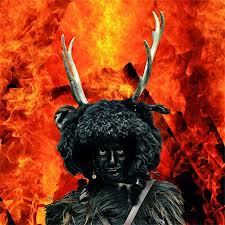Sei in: Cultura & Turismo » Storia e Tradizioni » Il Cervo di Castelnuovo al Volturno (Is)
Il Cervo di Castelnuovo al Volturno (Is)

Appartengono alla tradizione carnascialesca le feste del mese di Febbraio: tra le più suggestive è il rito dell’Uomo Cervo. Gl’Cierv, una pantomima che coinvolge molti abitanti del luogo sia come protagonisti che come figuranti, e si svolge nella piazza dell’abitato di Castelnuovo al Volturno, dopo il tramonto. Essa rappresenta la parafrasi del significato primordiale del Carnevale, l’antichissimo mito dionisiaco, nel quale il paesaggio delle stagioni è simboleggiato in maniera cruenta ed in cui, per la rinascita della natura, è indispensabile una morte sacrificale, e al tempo stesso è la figurazione di ciò che da sempre sconvolge l’animo umano: le radicate paure per l’irrazionale, l’incomprensibile, la violenza selvaggia della natura che sovrasta e a volte travolge. Una paura da esorcizzare e dominare, dunque, affinchè la vita assuma un aspetto gestibile, tranquillo, e cammini lungo la sicura via della normalità. Il sole è appena calato e l’aria fredda della sera comincia a sferzare le vie del borgo. Il pubblico, giunto già dal primo pomeriggio, gremisce la piazzetta in attesa dell’evento quando, inattese, riunite in un folto gruppo, si mostrano le janare, le streghe. Nere e grifagne, personaggi giunti dalla superstizione e dalla paura, muovono i passi cadenzati di un’angosciante danza. Sono le oscure messaggere di un avvenimento formidabile che, di lì a poco, sconvolgerà la quiete. E mentre la gente è ancora sconcertata da tali presenze, risuonano nell’aria le melliflue note delle zampogne. Con un incedere lento, ieratico, ecco gli zampognari, poi il Cervo, la Cerva, Martino, la Popolana, il Cacciatore: tutti partecipano al rito che vede prima la morte e poi la resurrezione de Gl’Cierv a nuova vita.
The Deer Castelnuovo al Volturno (Is)
They belong to the tradition of carnival festivals in the month of February: the most striking is the rite of Man Cervo. Gl'Cierv, a pantomime involving many local people and as players and as a set, and takes place in the main square of the town of Castelnuovo al Volturno, after sunset. It is the paraphrase of the primordial meaning of the Carnival, the ancient Dionysian myth, in which the landscape of the seasons is symbolized in a bloody and in which, for the rebirth of nature, it is essential to a sacrificial death, and at the same time is the representation of what always upsets the human soul: the deep-rooted fears of the irrational, the incomprehensible, the savage violence of nature that surpasses and sometimes overwhelming. A fear to be exorcised and dominate, then, so that life may take on a manageable, quiet, safe and walk along the path of normality. The sun has just dropped and the cold air of the evening begins to lash the town's streets. The audience, who arrived early in the afternoon, gremisce the square waiting for the event when, unannounced, gathered in a large group, we show janare, and witches. Black and grifagne, people came from superstition and fear, move the sequence of steps of a distressing dance. They are the harbingers of a dark event formidable, a little later, upset the peace. And while people are still puzzled by these presences into resound the mellifluous notes of the bagpipe. With a slow pace, hieratic, here is the pipers, then the Deer, the Fawn, Martino, Popolana, the Hunter: all participate in the rite which sees the first death, and resurrection of Gl'Cierv to life.


